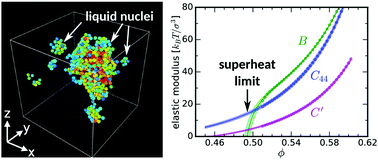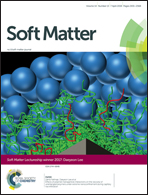Homogeneous melting near the superheat limit of hard-sphere crystals†
Abstract
A defect-free crystal can be superheated into a metastable state above its melting point and eventually melts via homogeneous nucleation. Further increasing the temperature leads to the metastable crystal becoming unstable and melting catastrophically once beyond its superheat limit. The homogeneous melting is not well studied near the superheat limit and this limit is difficult to measure accurately, even for the simplest model of hard-sphere crystals. Here our molecular-dynamics simulations identify its superheat limit at volume fraction ϕlimit = 0.494 ± 0.003, which is higher than the previous theoretical estimations. We found that the hard-sphere crystal at the superheat limit does not satisfy Born's melting criterion, but has a vanishing bulk modulus, i.e. a spinodal instability, which preempts other thermodynamic or mechanical instabilities. At the strong superheating regime, the nucleation deviates from the assumptions in the classical nucleation theory. In contrast to crystallization which often develops nuclei with various intermediate structures, the melting of face-centered cubic (fcc) hard-sphere crystal does not produce intermediate structures such as body-centered cubic (bcc) crystallites although bcc is more stable than fcc at the strong superheating regime. Moreover, we found that the time evolutions of the order parameters and the pressure all exhibit a compressed exponential function, in contrast to the stretched exponential relaxation of supercooled liquids. The compressed exponential functions have the same exponent, which poses a new challenge to theory.



 Please wait while we load your content...
Please wait while we load your content...